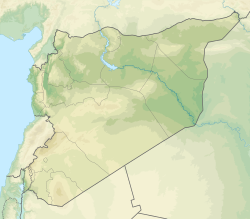Al-Atassi Mosque
Appearance
| Al-Atassi Mosque | |
|---|---|
مَسْجِد ٱلْأَتَاسِيّ | |
 The mosque in 2010 | |
| Religion | |
| Affiliation | Islam |
| Ecclesiastical or organisational status | Mosque |
| Status | Active |
| Location | |
| Location | Homs |
| Country | Syria |
Location of the mosque in Syria | |
 | |
| Geographic coordinates | 34°43′24″N 36°42′43″E / 34.7232°N 36.7119°E |
| Architecture | |
| Type | Islamic architecture |
| Style | Ottoman |
| Founder | Abdul Latif Pasha al-Atassi |
| Funded by | Al-Atassi family |
| Completed | 1913 CE |
| Construction cost |
|
| Specifications | |
| Capacity | 3,000 worshippers |
| Interior area | 3,000 m2 (32,000 sq ft) |
| Domes | 18 total;
|
| Minaret | 1 |
| Materials | Aleppo marble; ivory |
| [1] | |
The Al-Atassi Mosque (Arabic: مَسْجِد ٱلْأَتَاسِيّ, romanized: Masjid al-ʾAtāsīy), also known as the Great Al-Atassi Mosque, is a mosque in Homs, Syria. It is situated in a public park on the site of a former graveyard at the foot of the mound on which the remains of the citadel stand.
Completed in 1913 CE, the mosque is named after Hashim al-Atassi, three-time Syrian President from the Al-Atassi family, a prominent landowning and politically active family from Homs. The mosque features a late Ottoman style that combines lead domes and slender hexagonal minarets. It is notable for the colors of the Aleppo marble in the mihrab and the ivory pulpit.[2]
Gallery
[edit]-
The mosque in 2012
See also
[edit]References
[edit]- ^ مسجد الصحابي الجليل دحية الكلبي المعروف بمسجد آل الأطاسي أو آل الأتاسي. public.websites.umich.edu (in Arabic). Archived from the original on 11 December 2024. Retrieved 10 May 2025.
- ^ "Great Al-Atassi Mosque". Syrian Treasures. 8 August 2025. Retrieved 26 August 2025.
External links
[edit]![]() Media related to Al-Atassi Mosque at Wikimedia Commons
Media related to Al-Atassi Mosque at Wikimedia Commons
- "The Passing of a Syrian General Famed for Brutality". New Lines Magazine. 9 August 2022. Retrieved 26 August 2025.
- Parker, Joel (13 December 2016). "The Atassis of Homs: The rise and decline of one of Syria's founding families". The Journal of the Middle East and Africa. 7 (4). Tel-Aviv, Israel: Moshe Dayan Center for Middle Eastern and African Studies at Tel-Aviv University: 369–385.


